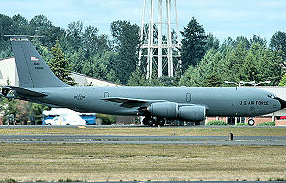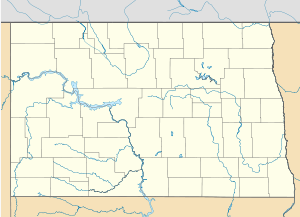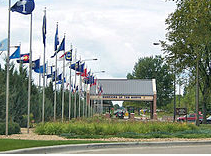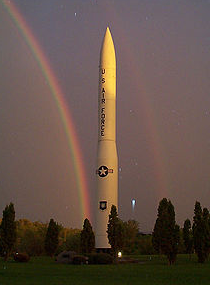
Grand Forks Air Force Base
USINFO | 2013-11-29 14:44
|
Grand Forks Air Force Base |
|
| Part of Air Mobility Command (AMC) | |
| Located near: Emerado, North Dakota | |
 KC-135R at Grand Forks AFB, North Dakota |
|
| Coordinates | 47°57′40″N 097°24′04″W / 47.96111°N 97.40111°W / 47.96111; -97.40111 (Grand Forks AFB) |
| Built | 1956 |
| In use | 1957 – present |
| Controlled by | United States Air Force |
| Garrison |
319th Air Base Wing |
| Airfield information | |||
| IATA: RDR – ICAO: KRDR – FAALID: RDR | |||
| Summary | |||
| Elevation AMSL | 913 ft / 278 m | ||
| Coordinates | 47°57′50″N 097°24′04″W / 47.96389°N 97.40111°W / 47.96389; -97.40111Coordinates: 47°57′50″N 097°24′04″W / 47.96389°N 97.40111°W / 47.96389; -97.40111 | ||
| Website | www.grandforks.af.mil/ | ||
| Map | |||
 KRDR Location of Grand Forks Air Force Base |
|||
| Runways | |||
| Direction | Length | Surface | |
| ft | m | ||
| 17/35 | 12,350 | 3,764 | Asphalt |
Grand Forks Air Force Base (AFB) (IATA: RDR, ICAO: KRDR, FAALID: RDR) is a United States Air Force base located north of Emerado, North Dakota and approximately 16 miles (26 km) west of Grand Forks, North Dakota. In the 2010 census, the base was counted as a CDP with a total population of 2,367.
The host unit at Grand Forks is the 319th Air Base Wing (319 ABW) assigned to the United States Air Force Expeditionary Center of the Air Mobility Command (AMC).
Grand Forks AFB was established in 1955. The 319th Air Base Wing is commanded by Colonel Christopher R. Mann and the wing Command Chief Master Sergeant is CMSgt David E. Carlson.
Units
Grand Forks AFB is the home of the Air Mobility Command's (AMC) 319th Air Base Wing (319 ABW). The 319 ABW is organized into two distinct groups: Mission Support and Medical.
319th Mission Support Group
319th Civil Engineer Squadron
319th Communications Squadron
319th Contracting Flight
319th Logistics Readiness Squadron
319th Force Support Squadron
319th Security Forces Squadron
319th Operations Support Squadron
319th Medical Group319th Medical Operations Squadron
319th Medical Support Squadron
319th Wing Staff Agencies319th Comptroller Squadron
Tenant Units at Grand Forks AFB are:
Air Force Office of Special Investigations
10th Space Warning Squadron (Air Force Space Command unit)
United States Customs and Border Protection (operating MQ-9 Predator Bs)
69th Reconnaissance Group (Air Combat Command unit operating RQ-4 Global Hawks)
History

Main Gate at Grand Forks AFB
Grand Forks Air Force Base was established on 1 December 1955, with construction beginning in the fall of that year. It was occupied for use on 28 January 1957. It was named after the neighboring city of Grand Forks, North Dakota.Air Defense Command
Due to the continuance of the Cold War between the United States and the Soviet Union, Grand Forks AFB was originally built as an Air Defense Command (ADC) fighter-interceptor air base. The site for the base was chosen in 1954 and the land was paid for by the citizens of Grand Forks, the site was located 15 miles (24 km) west of the city. The beginning of the 5,400-acre (22 km2) air base started in 1956 with the construction of a 12,300-foot (3,700 m) runway.
On 18 February 1957 the 478th Fighter Group (Defense) was activated at Grand Forks. The 18th Fighter-Interceptor Squadron was moved from Wurtsmith AFB, Michigan on 1 May 1960, and flew F-101B Voodoos until 15 April 1971 when it was inactivated and the Voodoos were retired. It was replaced by the 460th Fighter-Interceptor Squadron which was moved from Kingsley Field, Oregon. The 460th FIS flew F-106 Delta Darts until it also was inactivated on 15 July 1974.
In addition to the interceptor squadrons, In 1958 a Semi Automatic Ground Environment (SAGE) Data Center (DC-11) was established at Grand Forks. The SAGE system was a network linking Air Force (and later FAA) General Surveillance Radar stations into a centralized center for Air Defense, intended to provide early warning and response for a Soviet nuclear attack. DC-11 was operated by the Grand Forks Air Defense Sector (GFADS), activated on 8 December 1957 under the 31st Air Division at Snelling AFS, Minnesota. On 1 January 1959, GFADS was transferred to the operational control of the 29th Air Division at Malmstrom AFB, Montana.
SAGE operations were extremely expansive and GFADS was inactivated on 1 December 1963, when it was merged with the Minot Air Defense Sector at Minot AFB. With the inactivation of DC-11, Grand Forks AFB was reassigned from the Air Defense mission to Strategic Air Command.
In 1971, the 18th Fighter-Interceptor Squadron was inactivated and the 460th Fighter-Interceptor Squadron replaced the unit. In 1974, although the 460th Fighter-Interceptor Squadron won first place at the William Tell Air-to-Air Competition at Tyndall AFB, Florida, it was inactivated due to the restructuring of the air defense system, and ended the activities of ADCOM at Grand Forks.
The DC-11 SAGE blockhouse was later the Headquarters of the SAC 321st Strategic Missile Wing. With the end of LGM-30G Minuteman III operations in 1998, in June 2003, the large SAGE blockhouse was torn down.
Safeguard Anti-Ballistic Missile
On 3 November 1967, the Department of Defense revealed that Grand Forks AFB was one of 10 initial locations to host a Sentinel Anti-Ballistic Missile (ABM) site. With presidentRichard Nixon's 14 March 1969, announcement constructing a "Safeguard" installation at Grand Forks became a top priority. However, construction was stalled throughout mid-1969, as Congress debated the merits of BMD. Finally, after the Senate defeated amendments to kill Safeguard deployment, the United States Army proceeded under the assumption that appropriations would be forthcoming.
Survey teams selected sites in flat wheatlands close to the Canada-Minnesota border, north-northwest of Grand Forks. Twenty-five miles separated the 279-acre Perimeter Acquisition Radar (PAR) and the 433-acre Missile Site Radar (MSR) sites. Four remote launch sites of 36 to 45 acres each were to be situated in a circle with a 20-mile radius surrounding the MSR. Groundbreaking occurred at the PAR and MSR sites on 6 April 1970. Excavation proceeded rapidly, and the foundation holes for the PAR and MSR were in place by mid-May.
On 26 May 1972, President Nixon and Soviet general secretary Leonid Brezhnev signed the ABM Treaty, which limited each nation to one site to protect strategic forces and one site to protect the "National Command Authority." With work about 85 percent complete at Grand Forks, the United States chose to finish construction at the North Dakota site. On 21 August 1972, the Army Corps of Engineers turned over the PAR to the Safeguard Systems Command (SAFSCOM) Site Activation Team. The transfer of the MSR occurred on 3 January 1973. Work on the four remote launch sites fell behind schedule, with the last being completed on 5 November 1972. Testing of the PAR commenced during the summer of 1973.
On 3 September 1974, the SAFSCOM Site Activation Team was relieved by the U.S. Army Safeguard Command. Named the "Stanley R. Mickelson Complex"
WikiMiniAtlas
48°35′21″N 098°21′24″W / 48.58917°N 98.35667°W / 48.58917; -98.35667 (Stanley R. Mickelson Complex) (62.3 miles (100.3 km) northwest of Grand Forks AFB), the North Dakota ABM site received its complement of nuclear-tipped LIM-49 Spartan and Sprint Missiles during the following spring. The site was declared operational on 1 April 1975. Due to Congressional action, the Army operated the site for less than a year. With the exception of the PAR, the complex was abandoned in February 1976.
In October 1977, the PAR came under operational control of the Air Force, which operated it thereafter as part of its early warning system. It was designated as Cavalier AFS
WikiMiniAtlas
48°43′29″N 097°53′58″W / 48.72472°N 97.89944°W / 48.72472; -97.89944 (Cavalier AFS) (57.8 miles (93.0 km) north-northwest of Grand Forks AFB), and remains active. It is operated by the Air Force Space Command10th Space Warning Squadron (10th SWS).
Strategic Air Command

LGM-30 Minuteman III missile on display at the entrance of GFAFB.
On 1 September 1958, Strategic Air Command established the 4133d Strategic Wing at Grand Forks AFB, North Dakota as part of SAC's plan to disperse its B-52 Stratofortress heavy bombers over a larger number of bases, thus making it more difficult for the Soviet Union to knock out the entire fleet with a surprise first strike.
The 4133d SW was redesignated as the 319th Bombardment Wing (319th BW) on 1 February 1963 in a name-only redesigation and was assigned to SAC's Second Air Force, 810th Strategic Aerospace Division. Upon redesignation, the wing placed aircraft on peacetime quick reaction alert duty, and conducted global bombardment training for Emergency War Order operations and air refueling operations to meet SAC commitments.
In 1973, the 319th Bomb Wing acquired the AGM-69 Short Range Attack Missile (SRAM), replacing the older AGM-28 Hound Dog air-to-ground missile aboard its B-52Hs. As the activities in Southeast Asia decreased, the 319th Bomb Wing focused its full efforts on training crews to fly strategic strike missions.
On 1 November 1964, 321st Strategic Missile Wing was organized as the first Strategic Air Command (SAC) LGM-30 Minuteman II intercontinental ballistic missile wing, at Grand Forks AFB, North Dakota.
During 1965, the wing’s three missile squadrons were activated and crew training and certification began at Vandenberg AFB, California. In August 1965, the base received its first Minuteman II missile, shipped by train from Assembly Plant 77 at Hill AFB, Utah. During the following March, the base received the first Minuteman II to be shipped via aircraft, an Air Force first. In December 1986, the last B-52Gs permanently departed GFAFB, replaced by the B-1B Lancer in 1987. A change in the host unit occurred again, when in 1988, the 42d Air Division was assigned for base support in place of the 321st SMW.
Modern era
With the restructuring of the Air Force and the disestablishment of Strategic Air Command (SAC) in the early 1990s the wing first came under Air Combat Command (ACC) in 1992 and then under Air Force Space Command (AFSPC) in 1993.
On 1 February 1993 the Air Combat Command dropped the 319th Bomb Wing's primary nuclear mission and gave the wing the primary mission of B-1B conventional bombardment operations. The 319th Bombardment Wing began planning and training to support such a mission to counter worldwide regional threats.
The base was later transferred to the new Air Mobility Command (AMC) in 1994 following the departure of the last B-1B aircraft, redesignation of the 319 BW as the 319th Air Refueling Wing (319 ARW) and associated transfer of KC-135 aircraft assets to AMC, and transfer of strategic ICBM assets to Air Force Space Command (AFSPC).
In March 1995, the 1995 Base Realignment and Closure Commission selected the 321st Strategic Missile Wing for inactivation. The wing was first downgraded to group status, and the 321st Missile Group inactivated on 30 September 1998. GFAFB's first ICBM silo was imploded in accordance with the Strategic Arms Reduction Treaty (START II) in 1999 and the last silo imploded in 2001.
On 1 March 2011, the wing was redesignated as the 319th Air Base Wing (319 ABW).
Starting in May 2011, Grand Forks has a detachment of RQ-4 Global Hawks, operated by the 69th Reconnaissance Group Air Combat Command. The base received several new Block 40 Global Hawks, beginning in 2012.
Base realignment, 2005
In May 2005, DoD's2005 Base Realignment and Closure Commission recommended that GFAFB should be realigned. This would prevent the base from being closed, but would result in a significant loss in personnel levels as well as a loss of the tanker mission. To make up for these losses, the Air Force has decided to assign RQ-4 Global Hawks to Grand Forks, the first of which arrived in May 2011.
Major commands to which assigned
Air Defense Command, 25 July 1956
Strategic Air Command, 1 July 1963
Air Combat Command, 1 June 1992
Air Mobility Command, 1 October 1993–present
Major units assigned
Re-designated: 319th Air Base Wing, 1 March 2011 – present
|
|
Share this page



















